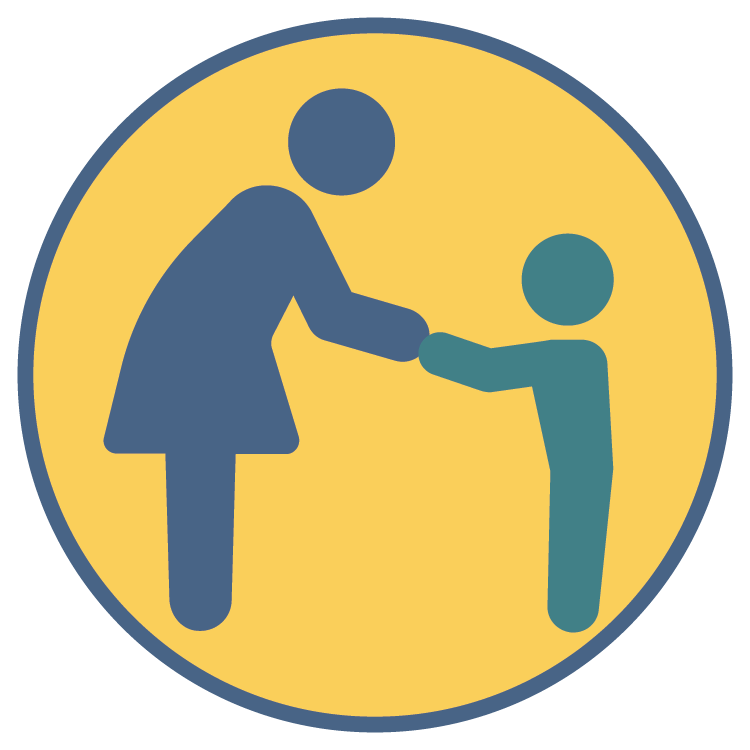Lesson 4 - Complex Language
In this lesson, you’ll meet children who are deafblind and use complex language (sometimes called "proficient communicators"). You’ll learn the many different ways they communicate, including how they access information and participate in classes. And you’ll learn strategies you can use to support their communication and concept development.
For more information, visit the National Center on Deafblindness at nationaldb.org.

Lesson 4 has three learning objectives. After completing the lesson, participants should be able to
- Describe the ways children who use complex language communicate
- Explain why two common assumptions about children who use complex language are incorrect
- Identify strategies that can be used to help expand the vocabulary and understanding of basic concepts of children who use complex language
Part 1 - How Do Children Who Use Complex Language Communicate?
Topics Covered
- Examples of children who use complex language
- Family members describe how they support their child’s communication
- Children describe how they connect with others
- Characteristics that complex language users share
- High-tech and low-tech support and accommodations
Activities
Instructors: The following activities can be adapted for a variety of purposes. For example, have participants turn in written or posted responses, or use the topics and questions as discussion starters. Some can be used for group activities.
Option 1
Suppose a new student has been enrolled in your school who is deafblind and uses complex language. What will you tell your teaching colleagues and administrators about the characteristics of children who are deafblind and use complex language? What sets them apart from children with typical hearing and vision?
Option 2
Children who are deafblind and are emerging or symbolic communicators typically require modifications to instruction to access the general education curriculum. Children who use complex language typically won’t require modifications but will need accommodations. What is the difference? Use specific examples in your answer.
Part 2 - Supporting Children Who Use Complex Language
Topics Covered
- Common misconceptions about children who are deafblind and use complex language
- How deafblindness impacts the use of complex language and access to contextual and incidental information
- Strategies to address the challenges faced by children who use complex language in school
Activities
Instructors: The following activities can be adapted for a variety of purposes. For example, have participants turn in written or posted responses, or use the topics and questions as discussion starters. Some can be used for group activities.
Option 1
Imagine that a new student named Todd has just been enrolled at your school in the grade level you teach. Todd is deafblind and uses complex language. Todd’s parents want him placed in the grade’s highest level math and science courses. A review of his transcripts show that Todd has received top marks in math and science at his previous school. Despite this, your administrator and several teachers are resistant to having him placed in the top classes because he is deafblind.
What might you tell them about children who are deafblind who use complex language and the assumption that they cannot be high-achieving students.
Option 2
You’ve learned of the many issues that complicate information gathering and communication for children who use complex language. Describe three of these issues and ways you could help a student who is experiencing them.
Part 3 - Expanding Communication and Concept Development
Topics Covered
- Strategies for expanding concepts
- The importance of direct experience
- Expanding knowledge of language, including idioms, slang, and analogies
- Supporting access to peers
Activities
Instructors: The following activities can be adapted for a variety of purposes. For example, have participants turn in written or posted responses, or use the topics and questions as discussion starters. Some can be used for group activities.
Option 1
Many children who are deafblind and use complex language are lacking in some basic concepts. Answer the following questions, and use specific examples to support your responses:
- Why are they lacking in basic concepts?
- How can you design your instruction so it better supports concept development?
Option 2
Describe one strategy you learned in this section for broadening the language of a child who is deafblind and uses complex language. Include specific examples of vocabulary and/or activities you might use.
Option 3
Children who are deafblind and use complex language often have lots of experience interacting with adults. What can you do to support a child’s access to and interaction with their peers?
Quiz
Instructors are welcome to use this quiz as-is or adapt it to meet their needs. It can be used to test participants’ knowledge following completion of the module or for pre- and post-test evaluation. To obtain answers to the quiz, instructors should contact support@nationaldb.org.
Additional Resources
NCDB Info Topic: Assistive Technology
Resources on the range of assistive technology that is available to augment communication, improve access to information, and increase independence
A Guidebook for Educational Sign Language Interpreters
Information on how to make sign language accommodations for students who are deafblind
Assessment of Deafblind Access to Manual Language Systems (ADAMLS)
Assessment of the influence of vision loss on the acquisition and use of manual communication forms (e.g., American Sign Language and other sign systems, fingerspelling, speechreading, cued speech) to guide the use of appropriate adaptations
An Introduction to Sign Language and Braille
One of a series of modules in the Open Hands, Open Access (OHOA): Deaf-Blind Intervener Learning Modules
